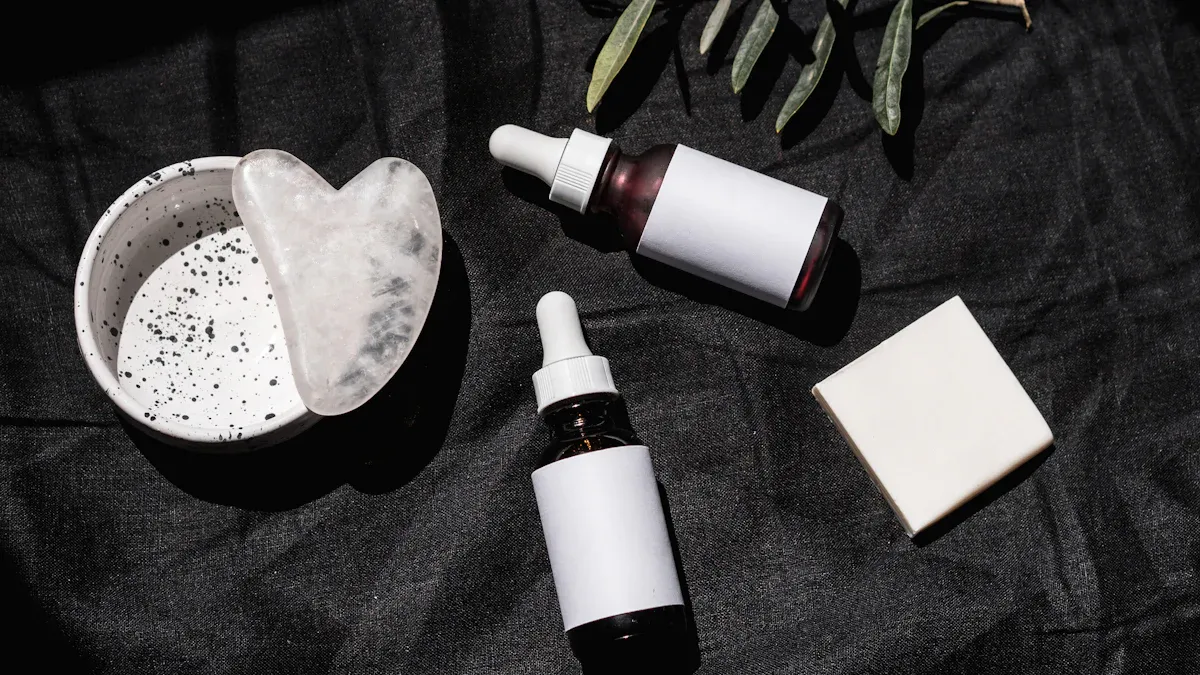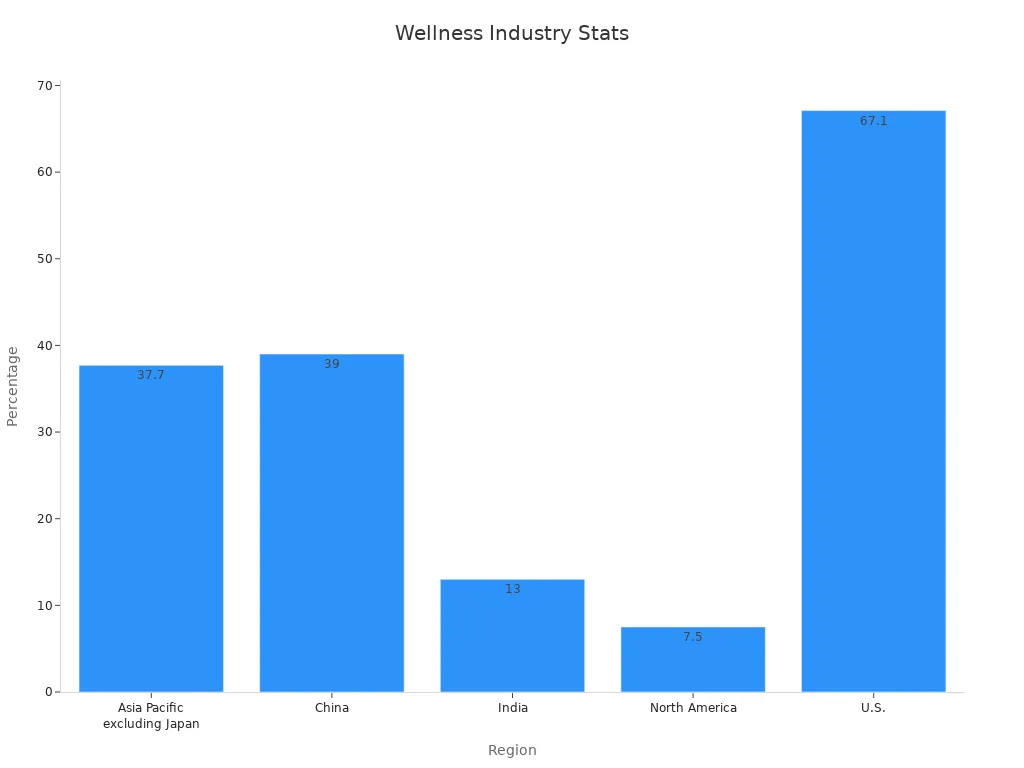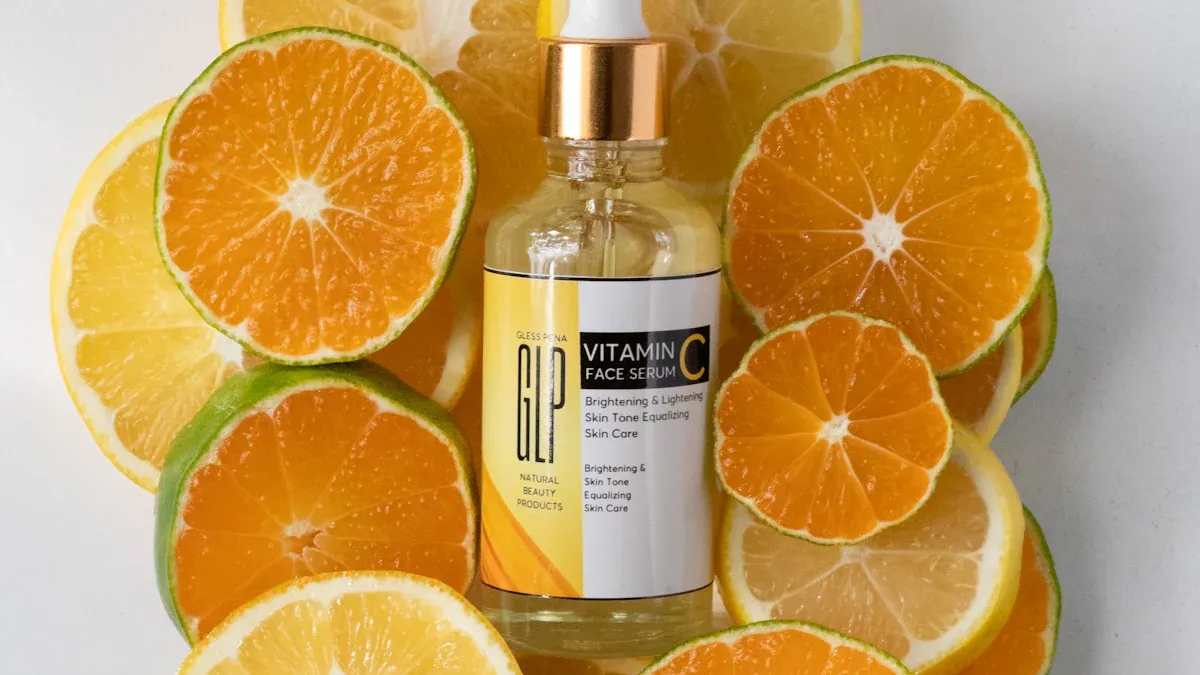
Ferulic Acid is making a significant impact in skincare and wellness. Consumers want natural ingredients that offer multiple benefits. A growing number of companies now focus on high-purity and eco-friendly solutions. The table below shows how the market for ferulic acid continues to expand:
| Metric/Segment | Statistic/Value | Significance/Insight |
|---|---|---|
| Global Market Size (2024) | USD 122.7 million | Baseline market size for ferulic acid in skincare and wellness |
| Projected Market Size (2034) | USD 241.4 million | Market size expected to double in 10 years |
| CAGR (2024-2034) | 7.0% | Steady annual growth rate |
| Personal Care & Cosmetics Share | 47.2% | Largest segment, driven by skincare demand |
| Natural Ferulic Acid Market Share | 57.5% | Preference for organic, eco-friendly ingredients |
| 98% Purity Ferulic Acid Share | 75.3% | Key role in high-efficacy cosmetics |
| North America Market Share | 43.3% | Regional leader in market adoption |
| North America Revenue (2024) | USD 53.1 million | Strong regional sales |

Scientific studies and product launches continue to increase. Researchers have published over 135 articles about ferulic acid’s benefits. Companies in Asia-Pacific and North America lead the way in innovation and market growth.
Key Takeaways
- Ferulic acid is a powerful natural antioxidant that protects skin and body cells from damage and aging.
- It helps reduce inflammation, supports skin health, and may protect brain function based on scientific studies.
- Ferulic acid is widely used in skincare, supplements, food preservation, and agriculture due to its safety and effectiveness.
- The market for ferulic acid is growing fast, driven by consumer demand for natural, clean, and eco-friendly products.
- Advanced technologies improve ferulic acid’s purity and stability, making products more effective and longer-lasting.
Impact
Skincare Transformation
Ferulic Acid has changed the way people care for their skin. It acts as a powerful antioxidant and helps protect skin cells like keratinocytes and fibroblasts. This ingredient also supports collagen and elastin, which keep skin firm and smooth. Many skincare products now include ferulic acid because it can brighten skin, slow down signs of aging, and help heal wounds. Companies use it in serums with vitamins C and E to boost protection against free radicals and sun damage.
Consumers want skincare that works and is safe. They look for products with clear ingredient lists and proven results. People now choose serums and creams with ferulic acid to target fine lines, dark spots, and uneven skin tone. Brands respond by offering more options that combine ferulic acid with other antioxidants for better results.
- Shoppers are more aware of what goes into their skincare.
- They want products that match their unique needs.
- There is a strong demand for clean, sustainable, and effective formulas.
Wellness Advancements
The wellness industry has seen major growth because of ferulic acid. This ingredient appears in dietary supplements, food products, and even pharmaceuticals. Companies invest in new ways to extract and use ferulic acid, making it more pure and effective. The market for natural antioxidants keeps growing as people focus on health and prevention.
| Growth Driver/Region/Innovation | Details | Impact on Wellness Industry |
|---|---|---|
| Rising demand for natural antioxidants | Increasing consumer preference for health benefits | Boosts ferulic acid use in skincare and dietary supplements |
| Asia Pacific Market Projection (2024-2032) | USD 51.22 million; CAGR 7% | Driven by urbanization, packaged food demand, and government support |
| High-purity natural ferulic acid segment | USD 62.88 million; CAGR 6.6% | Growth due to demand for potent antioxidants in food preservation and health products |
| Technological advancements | Enzyme-assisted extraction, biotechnological methods | Improve efficiency, purity, and bioavailability of ferulic acid, enabling innovative product formulations |
| Leading companies (e.g., BASF, Nature) | Investing in R&D for novel extraction and formulation | Enhances product efficacy and supports sustainable production aligned with wellness trends |

People now pay more for products labeled as natural. Younger generations, like Gen Z and Millennials, care about anti-aging and sun protection. The wellness market for ferulic acid will likely keep growing as more people seek healthy, science-backed solutions.
What is Ferulic Acid

Sources
Ferulic acid is a natural compound found in many plants. Scientists classify it as a hydroxycinnamic acid and a phenolic phytochemical. This compound appears in high amounts in maize, also known as corn. Studies of over 200 types of maize show that it contains more ferulic acid than other grains. The levels in maize remain stable even after cooking or processing, which makes it a reliable source. Bamboo shoots and popcorn also contain significant amounts. In plants, ferulic acid attaches to cell walls, helping to strengthen them. People can get ferulic acid from foods like whole grains, fruits, and vegetables.
Tip: Choosing whole grains over refined grains increases the intake of ferulic acid and other helpful plant compounds.
Properties
Ferulic acid has several important chemical and biological features. It is an amber-colored solid with the formula (CH3O)HOC6H3CH=CHCO2H. The structure includes special groups that allow it to act as a strong antioxidant. These groups help neutralize free radicals, which can damage cells. The table below highlights some key properties:
| Aspect | Details |
|---|---|
| Antioxidant Activity | Neutralizes free radicals and protects cell membranes from damage. |
| Structural Features | Contains methoxy and hydroxyl groups that support its antioxidant power. |
| Metabolism and Absorption | Absorbed in the small intestine and processed by the body for use and removal. |
| Anti-inflammatory Effects | Reduces substances in the body that cause swelling and irritation. |
Ferulic acid also crosses the blood-brain barrier, which means it can protect brain cells from stress and injury. Research shows that it may help reduce the buildup of harmful proteins in the brain, which links to diseases like Alzheimer’s. In nature, ferulic acid helps plants defend themselves and can even affect how other plants grow nearby.
Ferulic Acid Benefits

Antioxidant Power
Ferulic Acid stands out as a strong antioxidant. It helps protect skin and body cells from damage caused by free radicals. Free radicals are unstable molecules that can harm healthy cells and speed up aging. Scientists have tested how well Ferulic Acid works in real products. They found that when people use creams with Ferulic Acid, vitamin C, and vitamin E, their skin shows less damage from the sun. These creams lower redness and the number of sunburn cells after UV exposure. Tests also show that these products reduce DNA damage in the skin. When people take antioxidant supplements, their skin’s ability to fight off harmful molecules improves.
- Topical creams with Ferulic Acid, vitamin C, and vitamin E reduce UV-induced skin damage.
- These products lower redness and sunburn cell formation in human skin.
- DNA damage markers decrease after using these antioxidant solutions.
- Pretreatment with Ferulic Acid helps protect skin cells and immune cells from UV harm.
- Oral supplements with antioxidants boost the skin’s defense against free radicals.
Antioxidants like Ferulic Acid help keep skin looking healthy and young by fighting off daily environmental stress.
Anti-Inflammatory Effects
Ferulic Acid also helps reduce inflammation in the body. Inflammation can cause pain, swelling, and long-term health problems. Scientists have studied Ferulic Acid in animal models to see how it works against inflammation. The table below shows what they found:
| Aspect | Description |
|---|---|
| Study Model | Collagen-Induced Arthritis (CIA) in rats |
| Compound Tested | Ferulic Acid absorbed from Oldenlandia diffusa decoction |
| Methods | Scientists used special tests to find Ferulic Acid in the blood and measured levels of inflammatory markers. They also looked at joint health using X-rays and tissue samples. |
| Key Findings | Ferulic Acid entered the bloodstream after treatment. It lowered levels of inflammation markers (IL-1β and TNF-α). Rats showed less swelling and healthier joints. |
| Comparative Outcome | Ferulic Acid worked well, but was not as strong as the full plant extract. |
| Additional Evidence | Ferulic Acid reduced harmful proteins in joint cells and protected against bone and joint damage. |
| Conclusion | Studies in rats show that Ferulic Acid can lower inflammation and improve symptoms of arthritis. |
These results suggest that Ferulic Acid may help manage inflammation and support joint health.
Photoprotection
Ferulic Acid protects the skin from sun damage. Scientists have tested it in both lab and clinical settings. When combined with retinol, Ferulic Acid lowers stress and inflammation in skin cells exposed to UVB rays. This combination helps slow down signs of aging caused by the sun. Ferulic Acid also absorbs harmful UV rays and supports the skin’s natural defenses.
- Ferulic Acid, when applied before UVB exposure, reduces DNA damage and helps skin cells recover.
- It prevents the buildup of harmful immune cells and stops the release of inflammatory signals after sun exposure.
- Ferulic Acid protects important skin structures like collagen and elastin, which keep skin firm.
- It absorbs UV light, helping to prevent sunburn and dark spots.
- When mixed with vitamins C and E, Ferulic Acid makes these antioxidants more stable and effective. This mix gives the skin up to eight times more protection from sun damage than using the ingredients alone.
- Other combinations, such as with phloretin or beta-carotene, further improve skin elasticity and moisture.
- Clinical studies show that creams with Ferulic Acid reduce redness, improve skin tone, and keep skin hydrated after sun exposure.
Using products with Ferulic Acid can help protect skin from the sun and keep it looking bright and healthy.
Cognitive and Chronic Disease Support
Ferulic Acid may also help protect the brain and support long-term health. Scientists have studied its effects in animal models of Alzheimer’s disease. The table below highlights some key findings:
| Study Reference | Model Used | Key Findings | Statistical/Experimental Support |
|---|---|---|---|
| Ferulic Acid Ameliorates Alzheimer’s Disease-like Pathology and Repairs Cognitive Decline by Preventing Capillary Hypofunction in APP/PS1 Mice (2021) | APP/PS1 transgenic mice (Alzheimer’s model) | Ferulic Acid prevents blood vessel problems and improves memory in early Alzheimer’s stages | Statistically significant improvements in memory and blood vessel health |
| Protective effects of ferulic acid in amyloid precursor protein plus presenilin-1 transgenic mouse model of Alzheimer’s disease (2013) | APP/PS1 transgenic mice | Ferulic Acid reduces brain changes linked to Alzheimer’s and protects thinking skills | Experimental data show less brain damage and better behavior |
| Protective effects of a dimeric derivative of ferulic acid in animal models of Alzheimer’s disease (2016) | Animal models of AD | Dimeric Ferulic Acid improves memory and reduces brain damage | Behavioral tests and brain scans show clear benefits |
| Combined treatment with (-)-epigallocatechin-3-gallate and ferulic acid improves cognition and reduces Alzheimer-like pathology in mice (2019) | AD mouse models | The combination works better than either alone to improve memory and reduce brain changes | Statistical analysis supports the stronger effect |
| Ferulic acid as a β-secretase modulator improving behavioral impairment and Alzheimer-like pathology (2013) | Transgenic mice | Ferulic Acid changes brain chemistry to improve memory and reduce disease signs | Tests show real improvements in thinking and brain health |
These studies show that Ferulic Acid may help protect the brain and slow down memory loss. It could also support overall health by fighting damage linked to chronic diseases.
Applications
Skincare
Ferulic Acid plays a major role in modern skincare. Many brands use it in serums, creams, and sunscreens. This ingredient helps stabilize vitamins C and E, making them more effective. Products with Ferulic Acid protect the skin from sun damage and slow down signs of aging. Companies use new delivery systems, such as liposomes and nanoparticles, to improve how well the ingredient works. Leading brands like The Ordinary and La Roche-Posay include it in their formulas to boost skin radiance and elasticity. Consumers now look for natural and plant-based ingredients, and Ferulic Acid fits this trend.
Tip: Combining Ferulic Acid with other antioxidants can give the skin stronger protection against UV rays and pollution.
Dietary Supplements
Dietary supplements often contain Ferulic Acid for its antioxidant and anti-inflammatory effects. People take these supplements to support overall health, including gut and brain function. Advances in extraction and biotechnology have made Ferulic Acid more available and affordable. Supplement makers highlight their benefits for immune support and healthy aging. Studies show that Ferulic Acid can improve digestive enzyme activity and boost beneficial gut bacteria. The market for these supplements continues to grow as more people seek natural ways to stay healthy.
Food Preservation
Food companies use Ferulic Acid as a natural preservative. It helps keep foods fresh by stopping fats and oils from breaking down. In dried meats, Ferulic Acid reduces both spoilage and harmful bacteria. It works better than some traditional preservatives, such as nitrites, and does not carry the same health risks. Ferulic Acid also appears in food packaging materials, where it helps prevent oxidation and extends shelf life.
Agriculture
Farmers and researchers use Ferulic Acid to protect crops and improve plant health. Applying it to plants can increase their resistance to stress and disease. For example, Ferulic Acid helps pea plants fight off fungal infections and boosts antioxidant enzymes in wheat. Scientists also produce Ferulic Acid from agricultural waste, turning leftovers into valuable products. This approach supports sustainable farming and reduces waste.
| Product Category | Application Case Study / Use | Key Details |
|---|---|---|
| Cosmetics | Antioxidant, anti-aging, photo-protection | Stabilizes vitamins C and E; prevents pigment discoloration |
| Food Preservation | Preserving oranges, oils, biscuits | Inhibits oxidation and microbial growth; works with metals and amino acids |
| Agriculture | Reducing environmental stress in plants | Used with other compounds to help plants handle stress |
| Food Packaging | Antioxidants in packaging materials | Grafted onto chitosan for use in food packaging and cosmetics |
Trends
Market Growth
The ferulic acid market continues to expand worldwide. Analysts expect the market to grow at a compound annual growth rate (CAGR) of 8% by 2033. The natural ferulic acid segment grows even faster. Asia Pacific leads this growth, especially in countries like Japan, India, and China. Urbanization and higher demand for packaged foods drive this trend. The food industry now stands as the second-largest user of ferulic acid, thanks to its antioxidant properties. North America holds the largest market share, mainly because of strong demand in packaged foods and pharmaceuticals. Europe also plays a key role, with more companies using ferulic acid in personalized medicine.
| Aspect | Details |
|---|---|
| Market Size Projection | From US$ 64 million in 2020 to US$ 90 million by 2026 |
| CAGR (2021-2026) | 6.0% |
| Main Application Segments | Food, Cosmetics, Pharmaceuticals |
| Fastest Growing Region | Asia Pacific |
| Largest Market Share | North America |
Technology
New technology shapes how companies produce and use ferulic acid. Many invest in enzyme-assisted extraction and biotechnological methods. These methods increase purity and reduce waste. AI-driven machinery and optimized extraction processes improve efficiency by up to 15%. Green extraction technologies, such as supercritical fluid extraction, support eco-friendly production. Nano-encapsulation delivery systems help skincare products work better by improving how the skin absorbs ferulic acid.
- Enzymatic and biotechnological extraction improves yield and purity.
- AI-driven machinery boosts production efficiency.
- Green extraction methods lower environmental impact.
- Nano-encapsulation increases bioavailability in skincare.
Consumer Demand
Consumers want products that are both natural and effective. Ferulic acid appears in more foods, drinks, and cosmetics because people care about health and clean labels. The market for natural ferulic acid now holds over 61% share, showing a strong preference for plant-based ingredients. In cosmetics, ferulic acid makes up almost half of the market, especially in anti-aging and sun-protective products. The US market grows quickly, with a CAGR of 9.3%. Asia-Pacific also sees rapid adoption as more people seek natural solutions.
| Statistic / Insight | Value / Description |
|---|---|
| Market size growth (2023 to 2033) | USD 70.5 million to USD 123.9 million |
| Natural ferulic acid market share (2023) | 61.8% |
| Cosmetics application market share | 46.7% |
| US market CAGR (2024-2030) | 9.3% |
| Natural cosmetics sector growth | Projected CAGR over 10% |
Consumers now look for multifunctional products that support health, beauty, and wellness. This shift drives innovation and keeps demand for ferulic acid strong.
Challenges
Stability
Ferulic acid offers many benefits, but it faces stability issues. This compound can break down when exposed to light, air, or heat. Skincare products with ferulic acid may lose their effectiveness if not stored properly. Scientists work to solve this problem by using special packaging and advanced delivery systems. For example, they use dark bottles or airless pumps to protect the ingredients from light and oxygen. Some companies add stabilizers or combine ferulic acid with other antioxidants, such as vitamins C and E, to help keep it active longer.
Note: Keeping skincare products in a cool, dark place helps maintain their strength and quality.
Researchers also explore new ways to make ferulic acid more stable. Nano-encapsulation and liposome technology can shield the molecule from harmful conditions. These methods help the ingredients stay fresh and work better on the skin. As technology improves, more products will offer longer-lasting benefits.
Safety
Safety remains a top concern for both consumers and manufacturers. Clinical studies show that ferulic acid is safe for use in many products. Sunscreen formulas with ferulic acid and UV filters do not cause redness or irritation, even after sun exposure. In tests, these products increased sun protection by 37% for SPF and 26% for UVA protection. The results show that ferulic acid works well with other ingredients and does not harm the skin.
Doctors and scientists check for allergic reactions and other side effects. Most people can use ferulic acid without problems. The ingredient has a non-irritant profile and good skin compatibility. Companies continue to test new formulas to make sure they meet safety standards.
- Ferulic acid shows strong safety in topical products.
- It works well with other antioxidants and UV filters.
- Most users experience no irritation or allergic reactions.
Tip: Always test a new skincare product on a small area first to check for any reaction.
Runtai Chemical
Advantages
Runtai Chemical stands out as a trusted supplier of ferulic acid. The company uses advanced technology to produce high-purity ferulic acid. Many customers choose Runtai Chemical because of its strict quality control and reliable supply. The company invests in research and development to improve its products. Runtai Chemical holds important certifications, such as ISO and GMP, which show its commitment to safety and quality.
Key advantages of Runtai Chemical:
- High-purity ferulic acid for skincare and wellness products
- Modern production facilities with strict quality checks
- Continuous innovation through research and development
- Certifications like ISO and GMP for safety and quality
- Eco-friendly and sustainable manufacturing practices
Runtai Chemical helps brands create safe and effective products by providing consistent and pure ingredients.
The company also offers technical support to help customers use ferulic acid in new ways. Many leading brands trust Runtai Chemical for their ingredient needs.
Global Service
Runtai Chemical serves customers around the world. The company has a strong logistics network that ensures fast and safe delivery. It works with partners in North America, Europe, and Asia. Runtai Chemical understands the needs of different markets and adapts its services to meet them.
| Region | Service Features | Customer Benefits |
|---|---|---|
| North America | Local warehousing, quick shipping | Shorter lead times |
| Europe | Regulatory support, documentation | Easy market entry |
| Asia | Custom solutions, bulk supply | Cost-effective sourcing |
Runtai Chemical provides customer service in several languages. The team answers questions and solves problems quickly. Many customers value the company’s clear communication and reliable support.
Companies looking for a dependable ferulic acid supplier can trust Runtai Chemical’s global reach and expertise.
Ferulic Acid continues to shape the future of skincare and wellness.
- Scientists recognize its antioxidant, anti-inflammatory, and neuroprotective effects.
- Companies use it in cosmetics, food, and supplements because it is effective and safe.
- The market grows as more people want natural, plant-based products.
- Runtai Chemical offers high-quality supplies, supporting innovation and reliability.
Exploring ferulic acid can help brands create products that meet modern health and beauty needs.
FAQ
What does ferulic acid do for the skin?
Ferulic acid protects skin from damage. It fights free radicals and helps reduce signs of aging. Many people use it to keep their skin looking bright and healthy.
Is ferulic acid safe for daily use?
Most people can use ferulic acid every day. Studies show it rarely causes irritation or allergies. Always test a small area first.
Tip: Start with a low concentration if you have sensitive skin.
Can ferulic acid be used with vitamin C and E?
Yes, ferulic acid works well with vitamin C and E. This combination makes antioxidants stronger and helps protect skin from sun damage.
- Many serums use all three ingredients for better results.
Where does ferulic acid come from?
Ferulic acid comes from plants like corn, rice, and wheat. Manufacturers extract it from these sources for use in skincare and supplements.
| Source | Example |
|---|---|
| Grains | Corn, wheat |
| Vegetables | Bamboo shoots |
Does ferulic acid help with brain health?
Research suggests ferulic acid may protect brain cells. Scientists found that it can reduce memory loss in animal studies. More research in humans is needed.








